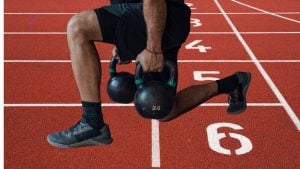Today, I will dive into how resistance training, including calisthenics, can significantly enhance your cycling performance. As you know from my previous posts I'm an avid cyclist. I use cycling to balance my strength training routine with endurance training. I've always been experimenting to constantly improve my FTP (Functional Threshold Power) and increase long-distance comfort on my gran fondo rides. I went into research mode and after reviewing a few academic papers I summarized the main takeaways in this article.
If you are also a runner, I wrote a similar post on how calisthenics can improve running performance.
The Science Behind Resistance Training and Cycling
Resistance training, whether it involves weights or body-weight exercises like calisthenics, plays a crucial role in enhancing cycling performance. Research has shown that combining endurance training with strength training can lead to significant improvements in various performance metrics. Specifically, studies have found that heavy strength training can improve cycling economy, which is the oxygen consumption required at a given submaximal exercise intensity.

Benefits of Resistance Training for Cyclists
As the saying goes: "If you want to get better at cycling, you got to be cycling", and there is some truth to that. On the other hand, cycling gets a lot more difficult as the weather gets colder and the days get shorter. This is a great time to build a workout plan and get into strength training so you can start your next season with a decent FTP boost and number of other benefit.
Improved Cycling Economy:
- Strength training, particularly heavy strength training, has been shown to enhance cycling economy. It led to reduced oxygen consumption, heart rate, blood lactate concentration, and rate of perceived exertion during prolonged cycling. This means that the cyclists’ bodies became more efficient, using less energy to maintain the same intensity .
- This means that cyclists can use less energy and oxygen to maintain a given speed, allowing for greater efficiency and endurance during long rides .
Increased Power Output:
- By increasing maximal strength, cyclists can improve their power output, especially during crucial moments like sprints, climbs, and accelerations.
Reduced Fatigue:
- With improved strength and muscle efficiency, the activation of less efficient type II fibers is delayed, which helps in prolonging endurance and maintaining higher intensities for longer periods.
- Cyclists who engaged in strength training experienced lower levels of fatigue, as evidenced by lower heart rates and perceived exertion during the last hour of a prolonged ride. This allows for sustained performance and better endurance during long-distance cycling .
Enhanced Muscle Fiber Composition:
- Strength training can induce beneficial changes in muscle fiber composition. It can lead to a conversion of fast-twitch type IIX fibers into more fatigue-resistant type IIA fibers, which are crucial for sustained, high-intensity efforts typical in cycling .
Increased Fractional Utilization of VO2max:
- This means you can use a higher percentage of your maximum oxygen uptake capacity, which is crucial for endurance performance.
Neuromuscular Efficiency:
- Resistance training enhances neuromuscular efficiency, meaning your muscles become more coordinated and effective at generating force. This leads to smoother and more powerful pedal strokes, optimizing your overall cycling performance .
Takeaways from the research papers
As a passionate cyclist, I’m always on the lookout for ways to improve my performance on the bike. Recently, I delved into some research that highlighted the importance of strength training for cyclists, and I was surprised by the positive impact it can have. If you’re like me, and you want to get stronger without compromising your endurance, these takeaways from scientific studies could be a game changer for your training.
Strength Training Won’t Compromise Your Endurance
A common myth among cyclists is that strength training might reduce endurance. However, research shows that incorporating strength work can actually improve your cycling performance without negatively affecting your endurance. The key is balancing your workouts, so you don’t overdo it on strength days and compromise your time in the saddle.
Why the Off-Season is Ideal for Strength Work
One of the best times to focus on heavy resistance training is during the off-season. This period allows you to work on getting stronger without worrying about hindering your on-the-bike sessions. When you’re not logging as many miles, you can dedicate more time to building muscle and increasing power, setting yourself up for a stronger base once cycling season kicks into full gear.
How to Structure Your Strength Workouts as a Beginner
When I first started strength training, I was overwhelmed by how much to do and how often to do it. Thankfully, the research provides clear guidance: start with 2-3 strength sessions per week, with at least two days of rest between each. This rest period ensures your muscles recover and grow stronger.
In the beginning, you can start with higher rep ranges (20-25 reps) and then, as you gain strength, move to lower rep ranges (4-6 reps) with heavier weights. As a beginner, you don’t need to do too much—one to three sets per session is enough to maintain strength.
Avoid Strength Training Right Before or After Cycling
To maximize your strength gains without hurting your endurance, you should avoid scheduling strength training right before or after a cycling session. Research recommends leaving at least 6-8 hours between your strength and cycling workouts. This gives your body time to recover and ensures you can fully benefit from both forms of exercise.
Focus on Compound Exercises for Maximum Benefits
The best strength training exercises for cyclists are compound exercises—those that work multiple muscle groups at the same time. These include:
• Squats
• Deadlifts
• Lunges
• Push-ups
• Dips
• Pull-ups
• Rows
These exercises target your legs, core, and upper body, which are all essential for improving cycling performance. Use heavy weights with low reps (4-6) to maximize the benefits. This approach not only builds muscle but also improves power output for better pedaling efficiency.
Core Work is Secondary—Focus on Your Legs
While core exercises are helpful, research emphasizes that leg work should be your primary focus. Exercises like squats and lunges already engage your core, so there’s no need to spend too much time on specific core workouts. However, if you want to add some core work, exercises like planks, push-ups, and sit-ups are a good addition to your routine.
Don’t Train to Failure—Leave Some in the Tank
I used to think that pushing myself to failure during every strength session would lead to the fastest gains. But research shows that there’s no need to hit failure to see results. Instead, aim for a perceived exertion of 7 to 9 out of 10. Rest for 2-3 minutes between sets, and take up to 5 minutes for heavier lifts. This allows for full recovery, so you can lift heavier and stronger on your next set.
Progress Into Base and Race Season by Reducing Volume
As the cycling season approaches, you should shift focus back to your bike. This means reducing the volume of your strength sessions—fewer sets per session—to make room for more on-the-bike training. This approach helps maintain the gains you’ve made in the off-season without compromising your endurance rides.
Progressive Overload is Key
One of the most important aspects of strength training is progressive overload. This means you should gradually increase the weight or difficulty of exercises over time. As you get stronger, continue to challenge yourself by adding more weight, doing more reps, or trying more difficult variations of exercises. This ensures you’re always progressing and improving your cycling performance.
Shallow Squats for Reduced Training Load In-Season
As the race season approaches, if you’re looking for a way to still get some strength work without too much fatigue, shallow squats can be a good compromise. This reduces the training load while still giving your legs the activation they need to maintain strength.
Weightlifting Beats Low Cadence Training
If you’re thinking of swapping strength training for low-cadence work on the bike, think again. Research shows that low cadence training is not a replacement for weightlifting. Strength work is more effective in building power and muscle mass that directly translates to improved cycling performance.
Stretching with Added Weight for Better Range of Motion
Flexibility is often overlooked, but it’s crucial for cyclists to prevent injury and improve pedaling efficiency. Adding some weight to your stretches can help improve your range of motion, which will make you more mobile and reduce stiffness after long rides.
Skip Light Weight Exercises—Go for the Heavy Stuff
If you’re serious about building strength, don’t waste time with light weight exercises. Focus on heavier lifts that challenge you and create real muscle adaptations. This is especially important if you’re aiming to increase power on the bike.
Don’t Forget Your Protein and Recovery
After a strength training session, protein is crucial for recovery. Aim for 30 grams of protein after each workout, ideally combined with carbohydrates to replenish glycogen stores. Protein shakes or smoothies are an easy and effective way to meet this requirement and support muscle repair.
Consider Creatine for Added Benefits
Lastly, research suggests that creatine supplementation can be beneficial for cyclists. It’s known to improve power output and muscle recovery, which could give you an edge both in strength training and on the bike.
Incorporating Calisthenics Into Your Routine
Calisthenics, a form of resistance training using body weight, is highly beneficial for cyclists. Here are some key exercises and their benefits:
Glutes, Quads, and Hamstrings:
- Squats: Stand with feet shoulder-width apart, bend knees and hips to lower down as if sitting in a chair, then return to standing.
- Benefit: Strengthens the entire lower body, crucial for generating power on the pedals.
- Lunges: Step forward with one leg, bend both knees to lower down, then push back to starting position.
- Benefit: Improves unilateral leg strength and balance, crucial for even power distribution during cycling.
- Glute bridges: Lie on your back, knees bent, feet flat, and lift your hips off the ground by squeezing your glutes.
- Benefit: Specifically targets and strengthens the glutes, a major power source for cycling.
Core:
- Plank: Hold a push-up position with forearms on the ground, body straight from head to heels.
- Benefit: Enhances core stability, improving overall balance and reducing back strain during long rides.
- Side plank: Lie on your side, propped up on one elbow, body straight, and hold.
- Benefit: Strengthens obliques, improving balance and stability while cornering and maneuvering.
- Crunches: Lie on your back, knees bent, and lift your head and shoulders off the ground.
- Benefit: Targets the rectus abdominis, supporting better posture and endurance on the bike. It also aids in power transfer.
- Leg raises: Lie on your back and raise your legs straight up towards the ceiling.
- Benefit: Engages lower abdominals, enhancing core strength and stability for a more powerful pedal stroke.
Back and Biceps:
- Pull-ups: Hang from a bar and pull your body up until your chin clears the bar.
- Benefit: Strengthens lats and biceps, which are important for climbing and pulling on the handlebars.
- Ring rows: Suspend yourself from rings, body straight, and pull your chest towards the rings.
- Benefit: Strengthens the upper back and biceps, improving upper body endurance and reducing fatigue. Similar to bar rows, but the instability of the rings increases core engagement and overall back activation, making it more functional for cyclists.
- Superman: Lie face down, arms and legs extended, and lift them off the ground simultaneously.
- Benefit: Strengthens the lower back and glutes, promoting stability and preventing injury.
- Bird dog: On all fours, extend one arm and the opposite leg, keeping your core engaged.
- Benefit: Enhances core stability and balance, improving overall bike handling and coordination.
- Reverse fly: Lean forward from the hips, holding weights, and lift your arms out to the sides.
- Benefit: Strengthens the rear deltoids and rhomboids, which are important for postural support during long rides.
Chest, Triceps, and Shoulders:
- Push-ups: Start in a plank position, lower your body down, and push back up.
- Benefit: Strengthens the chest, triceps, and shoulders, important for pushing the handlebars when climbing out of the saddle, also when maintaining an aerodynamic position.
- Dips: Use parallel bars or a chair to lower your body down and push back up.
- Benefit: Targets triceps and chest, improving upper body strength and endurance.
- Pike push-up: Inverted V position, hands on the ground, lower your head towards the ground and push back up.
- Benefit: Focuses on shoulders and upper chest, promoting better stability and power transfer.
Plyometric Exercises:
Jump squats: Perform a squat and explosively jump up at the top of the movement, landing softly back into a squat position.
- Benefit: Improves explosive power in the legs, important for sprinting and climbing out of the saddle.
Box jumps/ High jumps: Jump from the ground onto a stable elevated surface (like a box or bench), landing softly with both feet.
- Benefit: Builds explosive power and coordination, helping with quick accelerations and powerful pedal strokes.
In addition to these exercises, stretching is also important for improving flexibility and reducing muscle tightness, which can contribute to discomfort on the bike. Incorporate dynamic stretches before your rides and static stretches after your rides.
Remember, consistency is key. Incorporate these exercises into your regular routine 2-3 times per week to see the best results.
Consider incorporating exercises that mimic the cycling motion, such as single-leg squats and hip thrusts. These exercises can help improve your pedaling efficiency and reduce fatigue on long rides.
By focusing on these exercises and stretches, you can strengthen your muscles, improve your flexibility, and ultimately enhance your comfort and endurance on long-distance bike rides.
Don't Skip Calisthenics
The evidence is clear: strength training is not just for bodybuilders. It's a powerful tool that can help cyclists boost performance and reduce common injuries. By incorporating calisthenics training into your routine, you can improve your cycling economy, power output, and endurance, ultimately leading to faster and more enjoyable rides. More cycling makes you a better cyclist but it’s important to balance lower body strength with upper body strength as well as to address isolated issues with bodyweight exercises. You can do them at home and your cycling performance will thank you for it.
In case you want to listen to a deep dive I'd recommend Dylan Johnson's video:
Resources
Rønnestad, B. R., & Mujika, I. (2014). Optimizing strength training for running and cycling endurance performance: A review. Scandinavian Journal of Medicine & Science in Sports, 24(3), 603-612.
Rønnestad, B. R., Hansen, E. A., & Raastad, T. (2011). Strength training improves 5-min all-out performance following 185 min of cycling. Scandinavian Journal of Medicine & Science in Sports, 21(2), 250-259.



